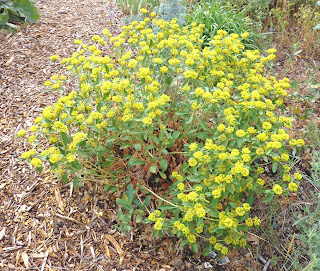It is ironic that the West which boasts dozens of stunning buckwheats is utterly trumped in the garden right now with this glowing mound of gold from West Virginia's shale barrens. Eriogonum allenii is one of the toughest, longest blooming and most rewarding perennials I know. I am amazed it is so little seen in gardens, considering Jelitto Seed company has been selling it for years.
Most any form of Escobaria vivipara is precious, but var. bisbeeana had flowers 3 inches across, I kid you not. This may have only bloomed two days, but more than made up in spectacle what it lacked in duration.
Such an unphotogenic plant. But I shall never be without Helichrysum plicatum: this is the most durable, long lived and adaptable of this immense genus. Hailing from the Mediterranean, it is also very drought tolerant. The flowers last for nearly a month, and even the seedheads are decorative afterwards. It exudes a heavenly fragrance somewhere between spice cake and curry sauce.
I have rhapsodized about Ziziphora somewhere before. The pale blue powderpuffs last much of the summer, and the aroma of bruised foliage is heavenly. I am not sure which species this is (a photograph from the Rock Alpine Garden): it looks very much like pamiroalaica or forms of clinopodioides we have grown in the past. Plants similar to this grew everywhere in the Altai and the Tian Shan: they should be growing in all our gardens as well (just think Thyme on Steroids)
And of course, oreganos. Here is one similar to O. scabrum performing marvellously on Sandy Snyder's enchanting crevice garden. We may have had desert heat for a month, but her garden is fresh and colorful and rewarding.
Although we could do with another good soaking rain!










Nice vignettes of your passion - compact plants. Soon to be everyone's passion as our lots shrink! That last image of the rock slabs and small plants always grabs me in the land of round boulders...rectilinear forms crucial in the garden. Funny to see cacti blooming up there, still!
ReplyDeleteWhen I visit Denver, I should leave you with some Damianita seed...might not like winter there, but who knows if it will be happy enough with your periodic 70-75F winter periods, to put up with your corresponding cold plunges?
Escobaria in the garden? Outside? I am So jealous!
ReplyDeleteMatt, my friend. We grow dozens of SPECIES of Escobaria outside, and dozens of FORMS of just vivipara outside, by the HUNDRED: and so can YOU! They are tough as nails and tolerate eastern winters just fine.
ReplyDeleteAs you will see soon!
That Escobaria var. bisbeeana is fantastic as is everything else.
ReplyDeleteThank you, Aaron: your Blog blew my mind! I've been through Twin Falls many a time, little realizing what I was missing: you have one of the most beautiful western gardens I have seen. Do come visit Denver when you get a chance!
ReplyDeleteThanks! The Dever garden is on my top 10 list. I hope too see it it one day.
ReplyDelete